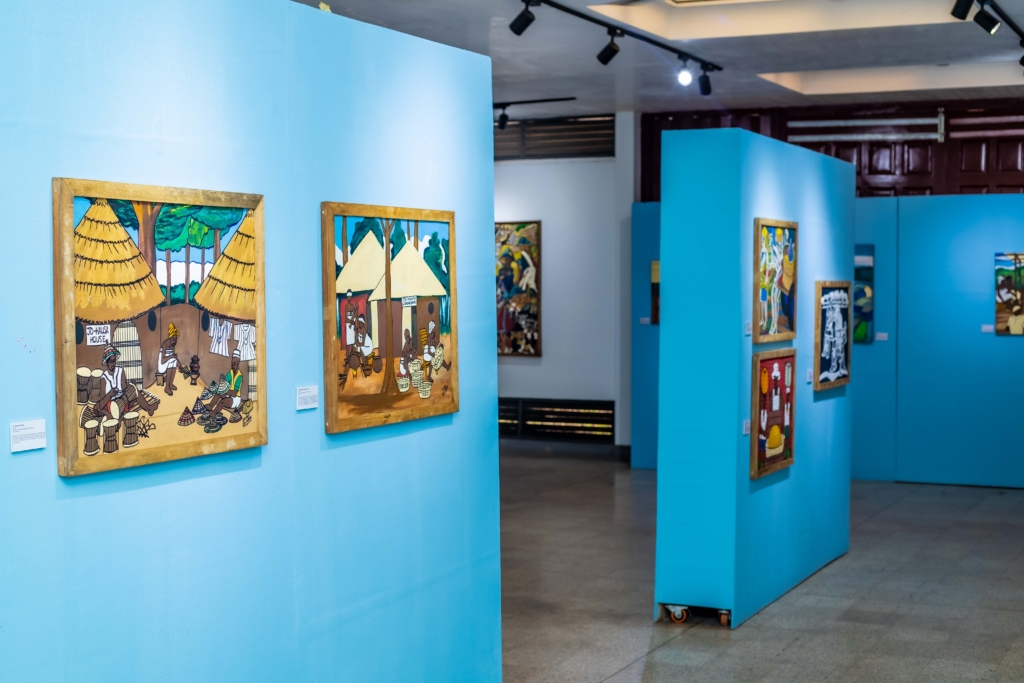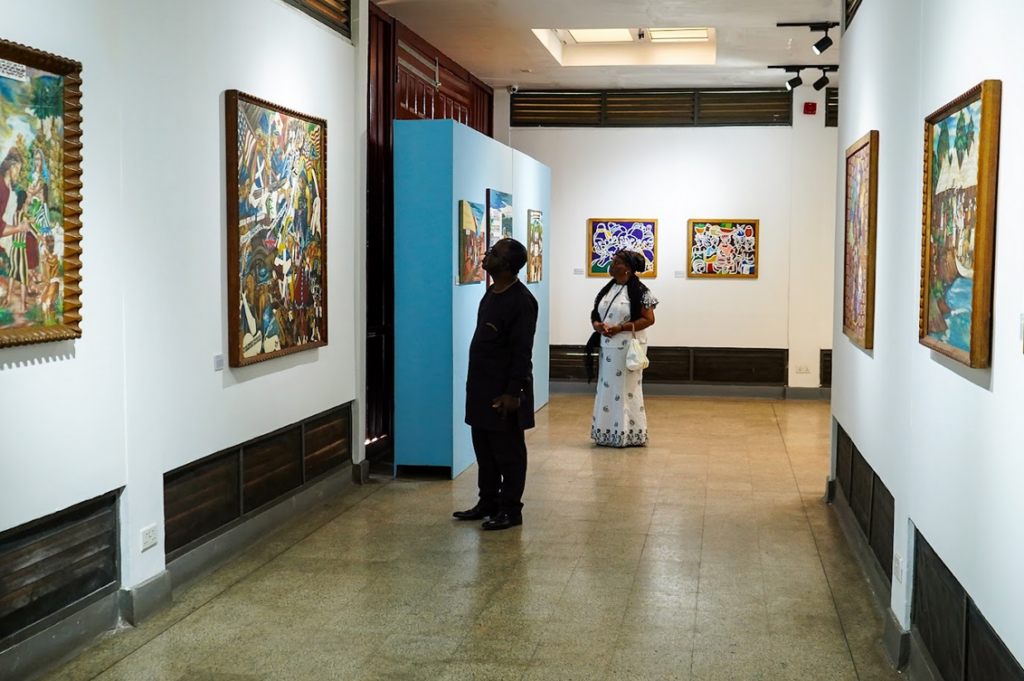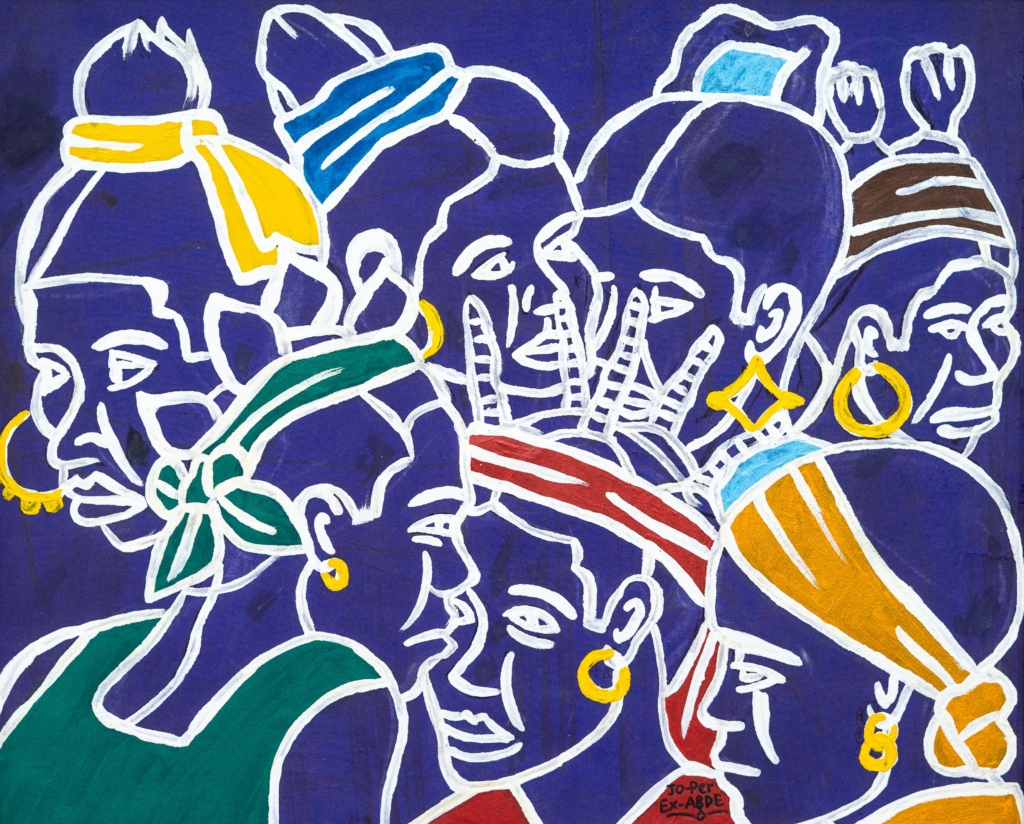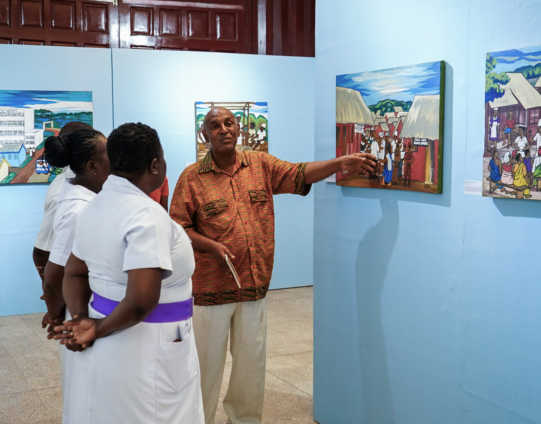Over the past 45 years, Jojo Abdallah has maintained a studio at the Accra Psychiatric Hospital, where his role alternates between patient, staff, and artist-in-residence.
The exhibition title is taken from Abdallah's hand-painted signboard for his studio at the hospital’s Occupation Therapy Department. The concept of ‘Psy-Technology’ brings together the artistic and scientific themes in his new solo show JOJO ABDALLAH: PSY-TECH.

Curated by Robin Riskin, the exhibition explores the intersection between psychology, technology, and art.
For the show, Abdallah presents paintings and mixed-media works depicting scenes, including psychiatric hospitals and ceremonial traditions, depicting Ghanaian cultural, political, and spiritual life.

Jojo Abdallah: Psy-Tech is produced by Compound House Gallery in collaboration with the Ghana Museums and Monuments Board and the Accra Psychiatric Hospital.
In this interview, Riskin shares insights about the show.
When you started talking with Jojo, what was his intent with this show? What conversations led to what is on view?
Jojo actually initiated the exhibition himself; this is his second show at the National Museum of Ghana in the past two years. He is a relentlessly committed artist who will create by any means and will find a way to share it. Jojo started on the body of work in PSY-TECH as soon as his last exhibition closed, and this collection is a bit more thematic.
The paintings explore global Ghanaian histories and hospitals; trade & travel, science & technology; syncretic spiritualities and knowledge systems; and Jojo’s own avatars. There is a special focus on Ga culture at the intersection of urban and rural life, and Ghana in changing states of governance and ecology.

The themes weren’t a pre-planned production—Jojo simply had a set of stories he wanted to tell, and he followed them one after the other. I retroactively scoured the collection and identified the resonant clusters. These thought clusters guide the spatial flow on-site at the Ghana Museum, as well as the narrative flow in the exhibition catalogue.
The concept of PSY-TECH comes from Jojo’s own philosophy, and from his beautiful marine blue signboard that labels his studio at the Occupation Therapy section of the Accra Psychiatric Hospital. For me, “PSY-TECH” speaks to the entanglement between psychology, technology and spirituality in navigating art and alternate dimensions.
PSY TECH is also a syllabus. Psy-Chy art is a rhythm toward creativity and to take your attention very, very. It’s also a world you can see inside the world. You see people and movements of other living and lively stock. That is also a world. Very interesting for you to open your being and what they have given you as psychiatric. Mine is Psychiatric Tech.” —Jojo Abdallah, 29 Jun. 2024, PSY-TECH exhibition opening.

Can you share the context of Jojo’s paintings narrating life at the intersection of history and fantasy?
Jojo’s “fantasy history paintings” deal with actual people, places and events, yet they combine and juxtapose the figures through seemingly non-sensical orders. For instance, Ga, Fante, Brong and Gold Coast can all be networked in the same signboard; or Gold Coast and Independence Republics can collectively commemorate a building or marketplace. The British, French, Romanians, “Jojo Kennedy”, and “Ga’s of Saudi Arabian Jews” may all have been present (from Jojo’s perspective) in the American Civil War. And the “Holy Spirit” of the Roman Catholic Church may trace back to “So-Lo” Elohim and cosmic flying squirrels.
It may sound absurd, but there’s an underlying logic to it, if we consider histories of trans-Atlantic exchange, trans-African exile, and etymological and technological transformation. It was important for me not to discipline or define Jojo’s art, but rather to absorb his liberated relationship to language, and to set it free. Jojo says that his histories come from research in libraries, museums, schools, media, and news sources, and I often wonder what happens between the page or the screen and his mind. I was instinctively drawn to this otherworldliness, and I wished to share it with others.

Reaction to the mention of Psychiatric hospitals in Ghana is often negative. When you started putting together this exhibition, was that at the top of your mind?
Very much so. I wanted to look at Jojo’s work as an artist first, and not to romanticise or be patronising toward his psychological condition of schizophrenia (which as you may notice, I haven’t mentioned until now). I think we are all on a spectrum, and those who choose to practice art professionally merely allow it more space in our everyday lives. I don’t see myself or any of us as so different from Jojo—I also have what you could call “disorderly and tangential thinking and communication”, and if I wish, I can tune into or speculate voices and visions from alternate realms. For me, that’s like prayer, that’s like creation, that’s like manifesting, seeking, and intuiting. So there is a kind of intimacy to how I curate Jojo’s work: not from a distance, but as someone inside it, and someone seeking to learn from it.
On the flip side—while I de-emphasised Jojo’s clinical condition, I was interested in highlighting the Accra Psychiatric Hospital’s role in the exhibition production. Coming from the blaxTARLINES KUMASI art community where inter-institutional networking has been crucial for regenerating cultural infrastructure from within, it was meaningful for me to organise an exhibition through the collaborative interaction of a state museum (the National Museum of Ghana), a state hospital (the Accra Psychiatric Hospital), and an experimental artist-led gallery (Compound House Gallery, founded by my dear friend and blaxTARLINES peer Nuna Adisenu-Doe).

The Psychiatric Hospital has played a formative role in Jojo’s creative journey, and hospitals widely feature in his paintings. Doctors Ekremet and Quartey contributed writing on art and therapy to the exhibition catalogue; as did Dr. Enyin Bentum “Paakow” Annan, an art-lover and medical doctor who coincidentally started volunteering at the Psychiatric Hospital the week after he met Jojo.
In the 1990s, then-Hospital Director J.B. Asare organised a number of shows for Jojo and other patients; over the years, the hospital has acted as an intermediary between Jojo and the Ghana Museum and Monuments Board. It is no small feat that Jojo has been able to keep a studio at the Hospital for 45 years, as I am told by his family (though if you ask Jojo, he will say 25 years). The space has created a certain freedom and support system for his art that is quite contradictory to the typical view of hospitals as sterile, silent, and sacrosanct.
Moreover, this is no ordinary state hospital—it started off as the Lunatic Asylum in the colonial Gold Coast in 1906, in a time and regime when mental patients were treated practically like prisoners. Conditions changed through Ghana’s independence and modernisation, and what is now the Accra Psychiatric Hospital is committed to therapy and care. The story of the Psychiatric Hospital is thus a story of transformation—one that is relevant to the field of curating. How do we navigate the tension between care and control in the institutionalisation of art objects and the cultures around them? How could we infuse clinical environments with the porousness, pleasure and power of everyday life and creation?
Was it deliberate not to make this show about the hospital only but general life in Ghanaian society?
Yes. Actually at the beginning of working on the show, I thought that the gravitation pull of Jojo’s paintings centred on Ghanaian hospitals. When we took the work to the Museum and tested how to lay it out, I saw that the core was global Ghanaian culture in general, where hospitals are one integral facet among many others. Coming into the Museum and being engulfed by the presence and power of generations of cultural knowledge, it became clear how Jojo’s art is part of the project of telling these stories, through poetry and fantasy rather than documentation and strict fact.

So when you enter the show, the Museum’s collection of artefacts and ancestral traditions leads straight into Jojo’s iconic paintings of “Ga’s First Awaking” and “Accra Psychiatric Hospital”. These paintings collectively tell stories of Ghana’s changing social fabric across traditional, colonial, and contemporary regimes: the Hospital as part of the society, and the society as part of the Hospital.
Coincidentally, there is an exhibition coming to the Museum—a collaboration between the Ghana Museums and Monuments Board, blaxTARLINES (Department of Painting and Sculpture at KNUST), and the University of Michigan Museum of Art—that explores artistic production around Ghanaian independence by recentring art of radical difference. Jojo’s art can be thought of as an extension or microcosm of this project; another of our world-within-worlds.

What was your approach to curating this show? How did you decide on what work to include? Does your role as an artist show up in curating this show? If yes, how?
My curating project is guided by Jojo’s own voice and vision, which it interweaves with a community of “curatorial companions”. I generated a set of conversations around Jojo’s art by sharing his work with his and my creative communities, which include artists, writers, musicians, doctors, designers, friends, and family. My curating narrates Jojo’s art by weaving together fragments of these interactions into textual, sonic, visual and filmic pieces. Some of these pieces are made by me, and some are made by people who were organically part of the process.

I call this project “schizophonic curating”, though at various points I have called it by other names (mycorrhizal, fungal, folklore, etc.). The point is to move away from expectations for omniscience, authority, objectivity, or singularity, and to move toward networked, polyrhythmic, poetic, abstracted, and interpersonal pieces and processes. Why? Curating has been stuck in the same “monocrop” crises as other modern industries, tasked with delimiting, describing, and packaging products for mass dissemination and consumption. But life itself is entangled, in motion, multiple, specific, and not fully knowable—so how could our narrative structures for mediating art reflect that?
For PSY-TECH, I was interested in linking Jojo’s art to alternate canons and rereading his clinical condition through ancestral knowledge systems. In communal and Afro-indigenous societies, shamans, diviners, and healers would commune with voices and visions from spiritual sources that people in the ordinary scope of society could not access. This was seen as a gift and power, not a disease or disorder. I wondered how my curating could honour Jojo’s experience and perspective by learning, loving, and applying it; by integrating its mashed and mingled approach to reality.

These strategies play out in how pieces are captioned through Jojo’s not-fully-coherent dialogue; how the exhibition catalogue flows between poetry, prose, therapy, and bricolage; how textual and sonic essays teleport between spaces, times, subjects, and universes; and how PSY-TECH interventions infiltrate the space of social media. My curating thus emerges as a creative cloak that interacts with Jojo’s art rather than freezing or stultifying it. Since I found myself incapable of comprehensively framing it, I rather opened passageways to the ineffable process of interpreting it.
Anything else you’d like to highlight?
The idea to take curating as a creative medium to reimagine comes from my teacher kąrî'kạchä seid’ou at the Kwame Nkrumah University of Science and Technology (KNUST) in Kumasi. He re-engineered dynamics in the College of Art at KNUST by (among other things) encouraging artists to take agency over their own curatorial framing, and encouraging curators to take agency over their exhibitionary forms and processes. This simple but brain-busting question altered my consciousness about art and life in general. I went through a journey of unhinging from curating forms as I knew them, and grappling for models from artists, ecologists, healers, forests, fungi, fig trees, and language itself. Working with Jojo helped me give these abstract, speculative, and social processes a tangible shape. His combination of in-depth research, narrative complexity, and factual fluidity freed my curating.

I would add that it was the musician Nii Noi Nortey who introduced me to Jojo in 2019, during music sessions at the Psychiatric Hospital with Nii Otoo Annan and Muziki. I took the concept for “schizophonic” curating from their friend and longtime collaborator Steven Feld, an American musician and ethnomusicologist who has been working with creatives in Ghana for the past two decades.
Feld’s writings on the politics of reproduction around polyrhythmic sound influenced some of the texts that I studied with kąrî on ethnographic paradigms in community art. Like Feld, Nortey, Annan, John Collins, Jesse Weaver Shipley, Panji Anoff, Reggie Rockstone, Colter Harper, and other musical philosophers who bridge the gap between theory and practice, I was curious how oral and rhythmic communication could be resonant tools for narrating and producing culture.
Latest Stories
-
GII, GACC, and CDD-Ghana advise political parties against electoral misconduct on December 7
2 mins -
‘The digital gate didn’t open for the digital man’ – Mahama mocks Bawumia
6 mins -
Road diversions announced ahead of mammoth NDC-NPP rallies on Thursday
29 mins -
SHSs break tomorrow for Election 2024
1 hour -
Judge orders retrial as jury finds ‘Sexy Don Don’ not guilty in JB Danquah’s murder
1 hour -
Bright Simons: Ghana’s shady e-Gate Project
2 hours -
Contested Election Results: The Transformative Role of Technology
2 hours -
Agomeda Basic School appeals for support to improve ICT education, learning conditions
2 hours -
Transport Ministry opens up for private sector partnerships to increase STC bus terminals
2 hours -
Stonebwoy’s Bhim Fest heads to the beach for 8th edition
2 hours -
Fuel price increase: Petrol at GH₵15.30, diesel going for GH₵15.80 a litre
2 hours -
Low-Carbohydrate Diets and Management of Type 2 Diabetes
3 hours -
Boosting your SME’s stability and profitability during election 2024
3 hours -
SSNIT OBS Cases: Ernest Thompson, others ordered to open defense, Hassana Kramer acquitted
3 hours -
Okyeame Kwame explains why modern popular songs don’t lyrically tell stories
3 hours

